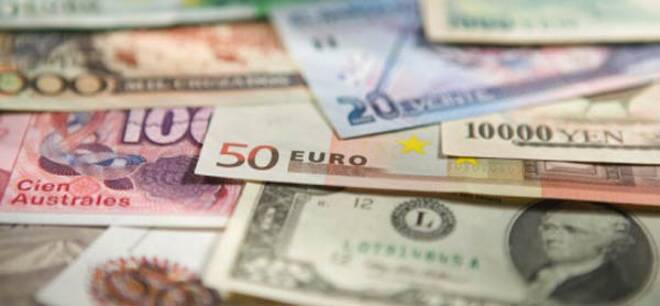Advertisement
Advertisement
The EUR/USD Holds Support but the Dollar Trend Continues Higher
By:
The EUR/USD moved lower but bounced near support as the dollar continued to gain traction as U.S. yield hit fresh highs. The 10-year yield sliced through
The EUR/USD moved lower but bounced near support as the dollar continued to gain traction as U.S. yield hit fresh highs. The 10-year yield sliced through the 3% level, following stronger than expected manufacturing data. Eurozone GDP came out in line with expectations and the German Zew sentiment index stabilized.
Technicals
The EUR/USD moved lower but bounced near trend line support which comes in near 1.1815. Resistance on the currency pair comes in near 1.1920. Short-term momentum has turned negative as the fast stochastic generated a crossover sell signal. The fast stochastic is printing a reading of 10, which is below the oversold trigger level and could foreshadow a correction.
Eurozone Q1 GDP was confirmed and in Line with Expectations
Eurozone Q1 GDP was confirmed at 0.4% quarter over quarter, as expected and in line with the preliminary estimate. The annual rate decelerated to 2.5% year over year from 2.8% year over year in the previous quarter. Separately industrial production data for March showed a rebound of 0.5% month over month from the -0.9 month over month slump in February. The main question not just for the ECB is whether this is mainly due to temporary factors such as adverse weather conditions, or the sign of a larger slowdown.
German ZEW investor confidence stabilized
German ZEW investor confidence stabilized in May and held steady at -8.2 – in line with Bloomberg consensus and still indicating that pessimists outnumber optimists. The current conditions reading came in a tad better and the less watched Eurozone expectations reading improved to 2.4 from 1.9 in the previous month. So signs of stabilization, but not sufficient evidence yet that Germany and the Eurozone as a whole will shrug off the weakness of the first quarter.
UK labor data showed expected perkiness in wage growth, which rose at a 2.9% year over year in the ex-bonus average weekly household income headline over the three months to March. This matched the median forecast, and marked a new cycle high rate after a slight pickup from the 2.8% year over year figure in the three months to February. The inflation-adjusted figure came in at +0.4% year over year. The official jobless rate came in at 4.2%, unchanged from the previous month and the lowest level since 1975, which was also a figure that had been expected. The employment rate came in at 75.6%, the highest rate since comparable records began in 1971. The number of economically inactive people also fell both on the three-month versus three-month and year over year comparisons, with the rate falling to 21.0% from 21.5% in the prior year.
French April HICP inflation was Unchanged
French April HICP inflation confirmed at 1.8% year over year, unchanged from the preliminary reading and up from 1.7% year over year in the previous month. The French reading is pretty much in line with the ECB’s definition of price stability now and at the same time data on wage growth this morning showed a marked rise to 0.7% quarter over quarter, from 0.4% quarter over quarter in Q4 last year.
German GDP growth slowed
German GDP growth slowed to just 0.3% quarter over quarter in Q1, in line with our forecast and a tad weaker than consensus, which predicted a deceleration to 0.4% quarter over quarter from the strong 0.6% quarter over quarter growth in Q4 last year. Construction but also equipment investment improved, private consumption picked up slightly. Government consumption contracted for the first time in 5-years, which may be a result of the political vacuum and the time it took to form a coalition government after the inconclusive election. Net exports lost momentum, with both exports as well as imports contracting compared to the last quarter of 2017. All in all pretty much as expected and the slowdown in partly due to temporary factors, including adverse weather conditions. The reported slowdown in trade momentum, however, will revive concerns about the future of world trade and add to the demands that Germany must strengthen domestic consumption and demand to balance the recovery.
About the Author
David Beckerauthor
David Becker focuses his attention on various consulting and portfolio management activities at Fortuity LLC, where he currently provides oversight for a multimillion-dollar portfolio consisting of commodities, debt, equities, real estate, and more.
Advertisement
